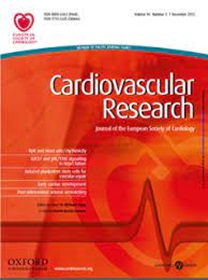The m6A demethylase ALKBH5 is a novel epigenetic regulator of aortic valve calcification
IF 10.2
1区 医学
Q1 CARDIAC & CARDIOVASCULAR SYSTEMS
引用次数: 0
Abstract
Aims Calcific aortic valve disease (CAVD) is a common heart valve disease with significant clinical consequences. The mechanisms that drive the pathogenesis of CAVD remain to be fully elucidated. N6-methyladenosine (m6A), the most prevalent RNA epigenetic regulator, has recently been implicated in cardiovascular disease, but its role in CAVD has yet to be investigated. In this study, we investigated the potential function of m6A modification in CAVD. Methods and Results Using clinical samples from CAVD patients in combination with human valve interstitial cell (hVIC) calcification model, we screened the expression of m6A modulators and discovered that ALKBH5 alkB homolog 5, RNA demethylase (ALKBH5), a key m6A demethylase, was significantly down-regulated in calcified hVICs and human aortic valves. Consistently, increased m6A levels were seen in calcified hVICs, and treated with 3-deazaadenosine (DAA), an inhibitor of m6A modification, significantly reduced hVIC osteogenic differentiation and calcification. In addition, we showed that silencing of ALKBH5 expression increased global m6A levels, and accelerated hVIC osteogenic differentiation and calcification, whereas overexpression of ALKBH5 resulted in the opposite effect. We demonstrated that ALKBH5 directly modulate m6A levels of TGFBR2 and its mRNA stability, leading to altered TGFBR2 expression and SMAD2 signaling in hVICs. We further showed that inhibition of TGFBR2 or knockdown of SMAD2 attenuated ALKBH5 knockdown-induced hVIC osteogenic differentiation and calcification. The expression of the m6A reader protein YTH N6-methyladenosine RNA binding protein F1 (YTHDF1) was upregulated during the process of hVIC calcification. Intriguingly, we revealed that the ALKBH5 silencing-induced increased hVIC osteogenic differentiation and calcification were abolished after knockdown of YTHDF1. These data suggest a potential role YTHDF1 in aortic valve calcification. Conclusion This study showed that ALKBH5 attenuated aortic valve calcification through the TGFBR2/SMAD2 signaling pathway via direct m6A modification of TGFBR2. .m6A去甲基化酶ALKBH5是主动脉瓣钙化的一种新的表观遗传调控因子
目的钙化性主动脉瓣病(CAVD)是一种常见的心脏瓣膜疾病,具有严重的临床后果。驱动CAVD发病机制的机制仍有待充分阐明。n6 -甲基腺苷(m6A)是最普遍的RNA表观遗传调节剂,最近被认为与心血管疾病有关,但其在CAVD中的作用尚未被研究。在这项研究中,我们研究了m6A修饰在CAVD中的潜在功能。方法与结果通过结合人瓣膜间质细胞(hVIC)钙化模型的CAVD患者临床样本,筛选m6A调节因子的表达,发现ALKBH5 alkB同源物5、关键的m6A去甲基化酶——RNA去甲基化酶(ALKBH5)在钙化的hVIC和人主动脉瓣中显著下调。一致地,钙化的hVIC中m6A水平升高,并且用m6A修饰抑制剂3-地氮杂腺苷(DAA)治疗,显著降低hVIC成骨分化和钙化。此外,我们发现沉默ALKBH5表达可增加全球m6A水平,加速hVIC成骨分化和钙化,而过表达ALKBH5则会产生相反的效果。我们证明了ALKBH5直接调节TGFBR2的m6A水平及其mRNA稳定性,导致hvic中TGFBR2表达和SMAD2信号通路的改变。我们进一步发现,抑制TGFBR2或敲低SMAD2可减弱ALKBH5敲低诱导的hVIC成骨分化和钙化。m6A解读蛋白YTH n6 -甲基腺苷RNA结合蛋白F1 (YTHDF1)在hVIC钙化过程中表达上调。有趣的是,我们发现ALKBH5沉默诱导的hVIC成骨分化和钙化增加在敲除YTHDF1后被消除。这些数据提示YTHDF1在主动脉瓣钙化中的潜在作用。结论本研究表明,ALKBH5通过直接m6A修饰TGFBR2,通过TGFBR2/SMAD2信号通路减轻主动脉瓣钙化。
本文章由计算机程序翻译,如有差异,请以英文原文为准。
求助全文
约1分钟内获得全文
求助全文
来源期刊

Cardiovascular Research
医学-心血管系统
CiteScore
21.50
自引率
3.70%
发文量
547
审稿时长
1 months
期刊介绍:
Cardiovascular Research
Journal Overview:
International journal of the European Society of Cardiology
Focuses on basic and translational research in cardiology and cardiovascular biology
Aims to enhance insight into cardiovascular disease mechanisms and innovation prospects
Submission Criteria:
Welcomes papers covering molecular, sub-cellular, cellular, organ, and organism levels
Accepts clinical proof-of-concept and translational studies
Manuscripts expected to provide significant contribution to cardiovascular biology and diseases
文献相关原料
公司名称
产品信息
索莱宝
neutral balsam
索莱宝
neutral balsam
 求助内容:
求助内容: 应助结果提醒方式:
应助结果提醒方式:


